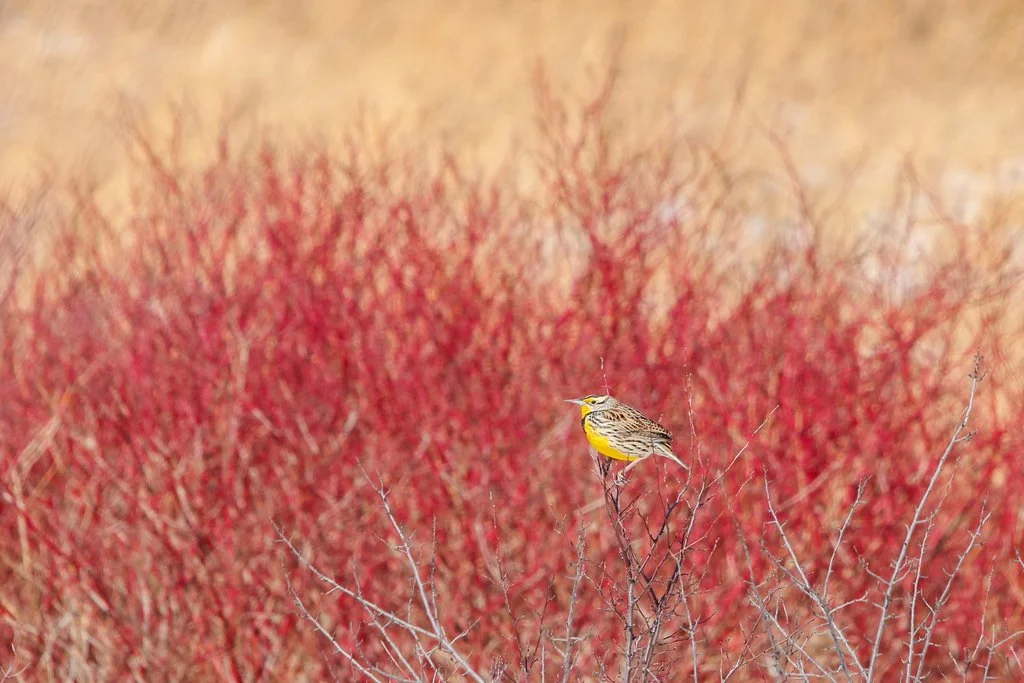Step onto the trails at Faville Grove Sanctuary this time of year, and you may hear spring before you see it. Author Willa Cather captured this perfectly in My Ántonia: “We heard the meadowlarks all about us. Their song told me everything I needed to know about spring.”
That unmistakable song—often translated by birders as “Spring is here!”—belongs to one of our most charming (and most threatened) grassland birds. Perched atop an isolated oak or swaying on a stalk of last year’s goldenrod, the Eastern Meadowlark greets the season with a sweet, flute-like call—iconic to Wisconsin’s prairies. To catch a glimpse (or better yet, hear the song) of an Eastern Meadowlark at Faville Grove, try visiting during mid to late morning in spring—males sing frequently until midday. Bring binoculars and scan low isolated shrubs or prairie hummocks and listen for their whistled phrases.
An Eastern Meadowlark sings from the top of a bare shrub in a golden prairie (photo by Jeff Steele/SoWBA).
The Eastern Meadowlark is not actually a lark, but a member of the blackbird family. They arrive at Faville Grove each spring, where the large, open landscape offers some of the best habitat in the area. Males arrive on territory in April, singing from high perches to attract mates and defend their ground. They begin establishing territories with dramatic “jump flights.” During this display, a male launches himself about 10 feet into the air with rapidly fluttering wings before landing several yards away. This behavior is often seen when two males are in dispute over territory, with one taking flight right after the other in a competitive show.
Each year, there are reports of Western Meadowlarks in southern Wisconsin, though these sightings are somewhat rare. In the central US, where the ranges of Eastern and Western Meadowlarks overlap, the two species typically avoid sharing territory. Their songs differ so drastically—almost like foreign languages—that they often fail to recognize each other’s territorial claims through song alone. As a result, the birds are more likely to engage in direct conflict to establish dominance.
An Eastern Meadowlark is perched conspicuously on a barbed wire fence (photo by Jeff Steele/SoWBA).
Interestingly, up to 80% of male Eastern Meadowlarks are polygamous, typically mating with two or three females. These females’ breeding cycles are usually staggered which helps minimize conflict. After pairing, the female selects a nest site directly on the ground. She builds a beautiful domed nest from grasses, weaving the stems through the surrounding vegetation to create a secure, concealed structure. One side remains open to serve as an entrance, often cleverly tucked beneath dense clumps of prairie grasses.
Eastern Meadowlarks have experienced a sharp decline—an alarming 75% population loss since 1966. If this trend continues, their numbers could be cut in half again within the next two decades. The root cause of this decline is habitat loss. Prairies and grasslands are disappearing. Small farms are vanishing under industrial agriculture and development. Practices like early mowing, overgrazing, and pesticide use further reduce nesting success—death by a thousand cuts. And with over 95% of meadowlark habitat on private land, conservation efforts on working farms are critical.
The Eastern Meadowlark is more than just a harbinger of spring—it’s a symbol of the American prairie and a proverbial canary in the coalmine (or perhaps hayfield), signaling the health of our grassland habitats. Places like Faville Grove Sanctuary are essential strongholds in the face of habitat loss, and each preserved acre helps ensure that future generations will also hear what Willa Cather once did—that spring has returned.
Written by Jeff Steele, Faville Grove Sanctuary land steward
Cover photo by Jeff Steele/SoWBA. An Eastern Meadowlark perches on a shrub. In profile, the bird has a bold yellow throat and chest with a black “V” and a very pointed grayish bill.







